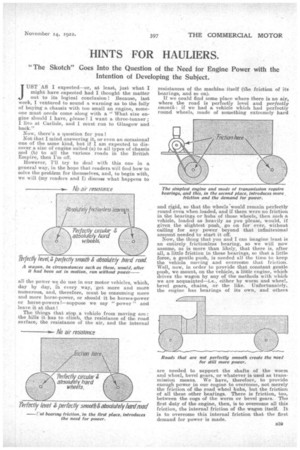HINTS FOR HAULIERS.
Page 23

Page 24

If you've noticed an error in this article please click here to report it so we can fix it.
"The Skotch" Goes Into the Question of the Need for Engine Power with the Intention of Developing the Subject.
JUST AS I expected—or, at least, just what I might have expected had I thought the matter out to its logical conclusion ! Because, last week, I ventured to sound a warning as to the folly of buying a. chassis with too small an engine, someone must needs come along with a "What size engine should I have, please.? I want a three-tonner ; I live at Carlisle, and I must run to Glasgow and back."
Now, there's a question for you!
Not that I mind answering it, or even an occasional one of the same kind, but if I am expected to discover a size of engine suited (a) to all types of chassis and .(b) to all the various roads in the British Empire, then I'm off.
However, I'll trY to deal with this one in a general way, in the hope that readers will find how to solve the problem for themselves, and, to begin with, we will (my readers and I) discuss what happens to
all the power we do use in our motor vehicles, which, day by day, rn every way, get more and more numerous, and, therefore, must be consuming more and more horse-power, or should it be horses-power or horse-powers ?—suppose we say " power " and leave it at that!
The things that stop a vehicle from moving are : the hills it has to climb, the resistance of the road surface, the resistance of the air, and the internal resistances of the machine itself (the friction of its bearings, and so on).
If we could find some place where there is no air, where the road is perfectly level and perfectly smooth: if we had a, vehicle which had perfectly round wheels, made of something extremely hard
and rigid, so that the wheels 'would remain perfectly round even when loaded, and if there were no friction in the bearings or hubs of those wheels, then such a vehicle, loaded as heavily as you please, would, if given. the slightest push, go on for ever, without calling for any power beyond that infinitesimal amount needed to start it off.
Now, the thing that you and I can imagine least is an entirely frictionless bearing, so we will now assume, as is more than likely, that there is, after all, a. little friction in those bearings, so that a little force, a gentle push, is needed all the time to keep the vehicle moving and overcome that friction. Well, now, in order to provide that constant gentle push, we mount, on the vehicle, a little engine, which drives the wagon by any of the methods with which we are acquainted—i.e., either by worm and wheel, bevel gears chains, or the like. Unfortunately, the engine 'has bearings of its own, and others
are needed to support the shafts of the worm and wheel, bevel gears, or whatever is used as transmission means. We have, therefore, to provide enough power in our engine to overcome, not merely the friction of the road wheel hubs, but the friction of all these other beatings. There is friction, too, between the cogs of the worm or bevel gears. The first duty of the engine, then, is to overcome all this friction, the internal friction of the wagon itself. It is to overcome this internal friction that the first demand for power is made. The next thing we shall find difficult to imagine is • a perfectly smooth road. What a hope, eh
Well, now, on this matter of the smooth road, 1 am going to tell you something which will rather surprise you. We have all got into the way of regarding the steel tyre as an anachronism—something of the past—and we have, lately, come to consider the. pneumatic as a thing of the future, the very near future, if not of the present. (I am talking about tyres for lorries, of course.) Well—it is, and it is not. If our roads were perfectly smooth and hard, smoother and harder than the best of new asphalt, as smooth and hard as a main-line railway track, then the best kind of tyres would he steel ones, smooth and strong, so that they would remain perfectly circular. That kind of tyre, on a perfectly level and hard road, would Ile easiest to drive.
I Say smooth and hard and keep on saying smooth and hard, because it is no use a road being smooth if it is soft, as I shall show. First, however, I want to explain why it must he smooth, or, more particularly, why a non-smooth road makes any difference to our need for power. There are no absolutely smooth roads. Even the least little crumb makes a difference, and on a very nice, good road, our smooth, hard wheel would keep meeting the little crumbs„ the tiny roughnesses on the road, and every time it met one it would have to climb up it, taking the whole weight of the wagon with it, dropping down again on the other side of it with a miniature bang. It is clear, then, that a, nonsmooth road demands power because, all the time, the wheel is climbing up the little roughnesses. In fact, so soon at a road ceases to be perfectly smooth, it ceases to be perfectly level,
Next week I will carry this subject further
THE SKOTC1I.
































